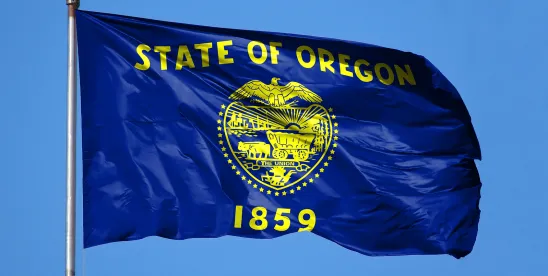Oregon law requires employers to provide employees with itemized wage statements on regular paydays. Such statements must include details, such as date of payment, dates of work covered, employee’s name, employer’s name and contact information, pay rates, gross and net wages, deductions, and hours worked. Statements can be provided electronically if the employee agrees.
Quick Hits
- Oregon employers are required to provide employees with itemized wage statements on regular paydays that include details such as pay rates, hours worked, and deductions.
- Effective January 1, 2026, employers in Oregon must also provide written explanations of earnings and deductions to all employees at the time of hire.
- Civil penalties of up to $500 may be assessed for noncompliance with the written explanation requirement.
With respect to deductions, employers are prohibited from withholding or deducting wages unless:
- Required by law
- Voluntarily authorized in writing by the employee for the employee’s benefit
- Authorized by a collective bargaining agreement or specific statutes
- Made upon termination of employment for repayment of a loan under strict conditions
Employers may be assessed penalties of up to $1,000 for violations of certain wage statutes, including unlawful deductions.
Effective January 1, 2026, Senate Bill 906 will require employers in Oregon to provide employees at the time of hire a written explanation of earnings and deductions on itemized statements with general information on:
(A) “The employer’s established regular pay period.
(B) A comprehensive list of:
- All types of pay rates that employees may be eligible for, including hourly pay, salary pay, shift differentials, piece-rate pay and commission-based pay.
- All benefit deductions and contributions.
- Every type of deduction that may apply.
(C) The purpose of deductions that may be made during a regular pay period.
(D) Allowances, if any, claimed as part of minimum wage.
(E) Employer-provided benefits that may appear on the itemized statements as contributions or deductions.
(F) All payroll codes used for pay rates and deductions, along with a detailed description or definition of each code.”
The law applies to all employers in Oregon except the federal government and its agencies. Employers may satisfy the requirement of providing this written explanation by making the information available to employees in a location easily accessible to them, such as on a website, a physical document in a central location, a shared electronic file, or delivery by electronic mail. The information in the written explanation must be “sufficiently detailed to explain pay rates and deduction codes, but need not be written in complete sentences.” Employers must update and review the required information by January 1 of each year. The Oregon Bureau of Labor and Industries (BOLI) will develop and make available a model written guidance document that employers may use and customize to satisfy the written explanation requirements detailed above. The law authorizes the BOLI to assess civil penalties for violations up to $500.
Next Steps
Employers may want to review and update payroll practices to ensure compliance with the new transparency requirements by January 1, 2026. Employers may also want to monitor developments from the Oregon Bureau of Labor and Industries for additional guidance.





 />i
/>i

